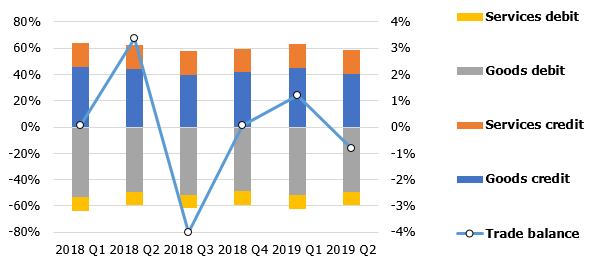The current account deficit stood at 1.3% of GDP in the second quarter

With the value of exports of goods declining and thus exerting a downward pressure on the overall trade balance, the current account overall recorded a deficit of 96.8 million euro or 1.3% of GDP in the second quarter of 2019.
The deficit of the balance of trade in goods increased quarter-on-quarter to –9.1% of GDP on account of a decline in the value of exports (–5.3% year-on-year) in parallel with a rise in the value of imports (4.5% year-on-year). The value of exports of goods decreased mostly for the groups of goods associated with the re-export trade flows, such as machinery, metal products. Meanwhile, products of wood, a group of goods that has continuously supported export growth, experienced a fall in the unit value as well as the volume of their exports. At the same time, the value of imports of goods increased mainly on account of the imported products of the chemical industry and mineral products. The above decline in re-export flows is also confirmed by shrinking imports of machinery and metal products.
The surplus of the balance of services expanded to 8.3% of GDP in quarter-on-quarter terms and, thus, continued the previously observed trend of imports growing at a slightly more rapid rate than exports (nonetheless, the net balance is still increasing). In the breakdown by service group, growth of transportation services, information and communication technology services and other business services support both exports and imports. Taking into account both the balances of goods and services, the overall balance of trade posted a deficit of 0.8% of GDP in the second quarter of 2019.
Trade balance (% of GDP)

In the second quarter of 2019, the largest flows recorded on the primary income account showed no notable deviations from the recent levels: the balance recorded a deficit of 133.4 million euro or 1.7% of GDP on account of dividends paid to foreign investors which were partly offset by positive flows of remuneration of employees and financing from the European Union (EU) funds. Meanwhile, in the second quarter of 2019 the relatively more volatile flows of secondary income account recorded a surplus amounting to 99.7 million euro or 1.3% of GDP where the contributions to the EU budget from value added tax and gross national income own resources were in balance with the net positive flows of transfers of EU funds, households as well as other financial corporations.
In the second quarter of 2019, the financial account posted decreases in both assets (–904.5 million euro) and liabilities (–1420.8 million euro) reflecting a net outflow of financing. The largest flows are related to a decrease in government liabilities in the form of short-term deposits and loans respectively as well as a decrease in the short-term deposits of monetary financial institutions and the general government on the liabilities side.
With respect to dividends paid to foreign investors (including those calculated in the previous quarters), direct investment in Latvia shrank by 61.5 million euro or 0.8% of GDP in the second quarter of 2019. Nonetheless, in the first half of 2019 overall foreign direct investment in Latvia amounted to 110.8 million euro or 0.8% of GDP.
Textual error
«… …»




